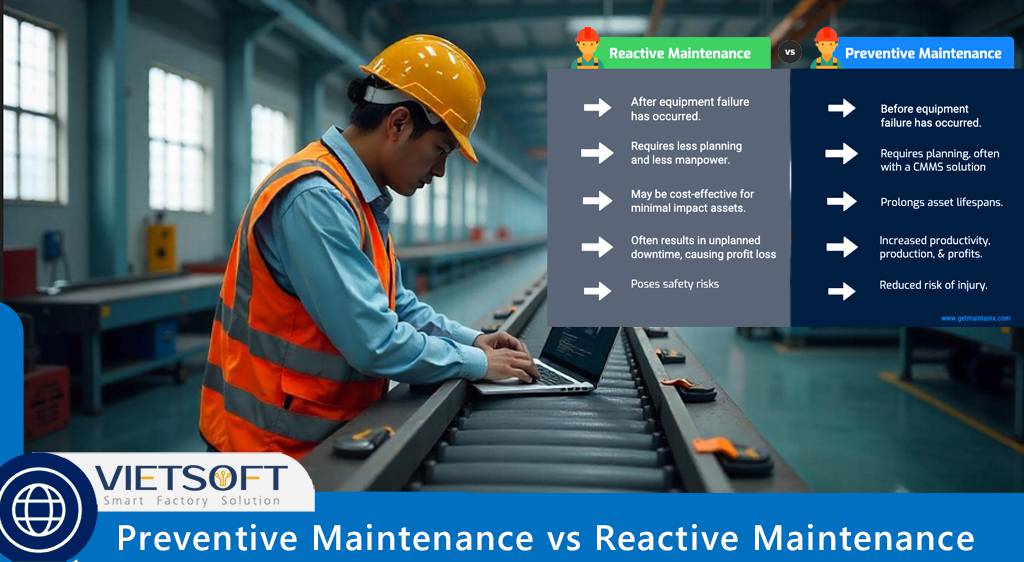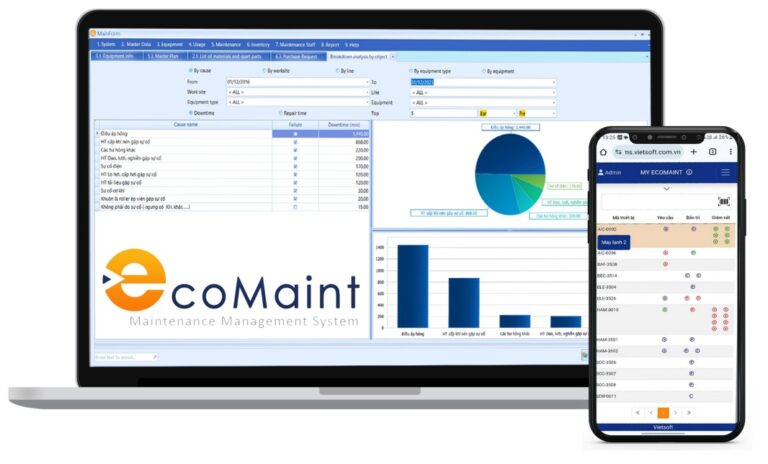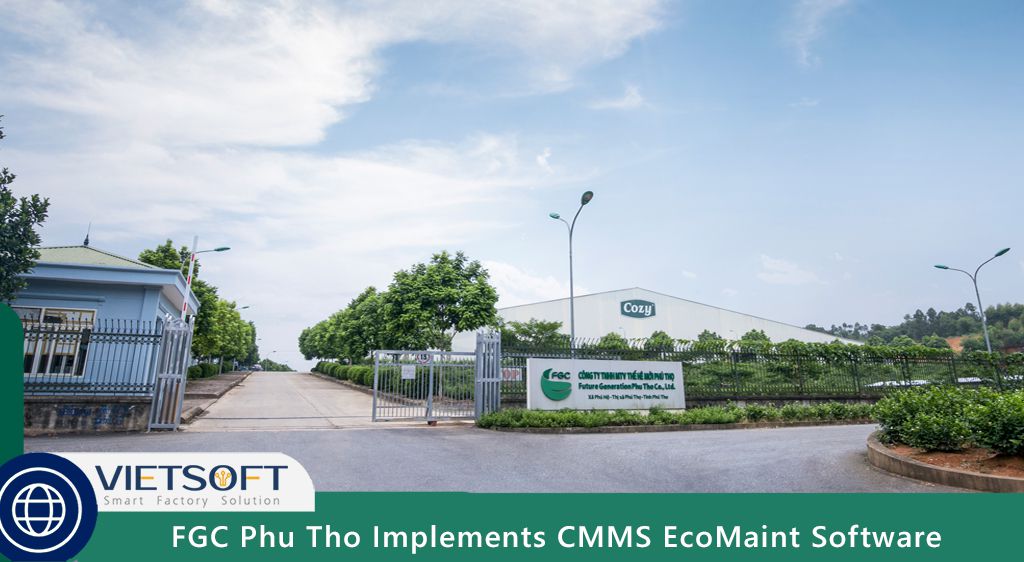
I. Understanding the Basics of Preventive Maintenance vs Reactive Maintenance
In the world of industrial maintenance, two primary strategies stand out: Preventive Maintenance vs Reactive Maintenance. These approaches define how businesses manage their equipment and facilities, directly impacting operational efficiency, costs, and safety. I’ve seen firsthand how these strategies shape the longevity and performance of critical assets.
Preventive Maintenance involves a proactive approach where scheduled inspections, servicing, and minor repairs are conducted to prevent equipment failures before they occur. This strategy is designed to extend the life of machinery, reduce unexpected downtime, and optimize resource use. On the contrary, Reactive Maintenance waits for equipment to fail before taking action, focusing on immediate repairs to restore functionality. While this method might seem cost-effective initially, it often leads to higher long-term expenses and operational disruptions.
Understanding the distinction between these two is crucial for maintenance teams and facility managers. Preventive Maintenance vs Reactive Maintenance isn’t just a choice but a strategic decision that influences a company’s bottom line and reputation. Let’s dive deeper into each approach to uncover their mechanics, benefits, and challenges.
1. What Is Preventive Maintenance?
Preventive Maintenance is a planned strategy aimed at keeping equipment in peak condition through regular upkeep. It includes tasks like lubrication, filter changes, and routine inspections, all scheduled based on time, usage, or condition monitoring. The goal is to catch potential issues early, preventing them from escalating into costly breakdowns.
For instance, consider an HVAC system in a manufacturing plant. Regularly cleaning coils and replacing filters as part of a Preventive Maintenance plan can prevent overheating and inefficiency. This approach not only extends the system’s life but also ensures consistent performance, which is vital for production schedules.
The concept isn’t new—pioneered by the U.S. Navy to enhance ship reliability, it has since been adopted across industries. By allocating resources to Preventive Maintenance, businesses can achieve up to 18% savings on operational costs, according to industry studies. This proactive mindset reduces the risk of catastrophic failures, making it a cornerstone for modern maintenance management.
2. Exploring Reactive Maintenance in Detail
Reactive Maintenance, often called “run-to-failure,” kicks in only after equipment breaks down. It involves diagnosing the issue and performing repairs or replacements to get things running again. This could range from fixing a stalled conveyor belt after an unexpected stoppage to replacing a burned-out motor in an emergency.
This strategy works well for low-priority or inexpensive assets, like a rarely used office printer, where the cost of prevention outweighs repair. However, applying it to critical machinery, such as a production line robot, can halt operations and inflate costs due to urgent part sourcing and overtime labor.
While simple to implement with no upfront planning, Reactive Maintenance’s unpredictability can lead to safety hazards and shorter asset lifespans. For example, neglecting regular motor maintenance might cause a sudden failure, requiring expensive overhauls. This reactive approach, though sometimes necessary, often proves less efficient compared to its preventive counterpart.
II. Key Differences Between Preventive Maintenance vs Reactive Maintenance
The core difference between Preventive Maintenance vs Reactive Maintenance lies in their timing and intent. Preventive Maintenance is proactive, scheduling tasks to avoid failures, while Reactive Maintenance is reactive, addressing issues post-failure. This shift in approach affects cost, downtime, and asset longevity.
Preventive Maintenance uses time-based or condition-based schedules, leveraging tools like vibration analysis to predict wear. For example, a pump might be serviced every 500 hours of operation to prevent seal leaks. In contrast, Reactive Maintenance waits for the pump to fail—perhaps causing a flood—before acting, leading to unplanned downtime.
Cost-wise, Preventive Maintenance might involve a $200 monthly service fee, saving thousands by avoiding a $5,000 emergency repair. Reactive Maintenance, however, can see costs spiral with unexpected parts and labor, often doubling or tripling initial estimates. These differences highlight why balancing the two strategies is key to optimized operations.
III. Benefits of Adopting Preventive Maintenance
Embracing Preventive Maintenance offers tangible benefits that enhance operational success. First, it significantly reduces downtime. By addressing wear before it leads to failure, businesses maintain production schedules—critical in industries like manufacturing where a single hour of downtime can cost $50,000 or more.
Second, it extends asset lifespan. Regular lubrication and part replacements ensure machinery operates within design parameters, potentially adding years to its service life. For instance, a well-maintained generator might last 20 years instead of 15, deferring costly replacements.
Third, safety improves as regular checks minimize accident risks. A faulty press machine, if ignored, could injure workers, but Preventive Maintenance catches issues like worn brakes early. Additionally, energy savings from efficient equipment operation and lower insurance premiums for documented upkeep further boost the financial case for this strategy.
IV. Drawbacks of Preventive Maintenance and How to Mitigate Them
While Preventive Maintenance is highly effective, it comes with challenges. The upfront cost can be a hurdle, especially for small businesses. Implementing a program might require investing in tools, training, and software, potentially costing $10,000 initially. However, this pales compared to the $600 million deferred maintenance deficit seen in some public institutions due to neglect.
Another drawback is the risk of over-maintenance, where excessive servicing wastes resources. To mitigate this, use condition-based monitoring to service only when needed, like replacing a bearing only when vibration exceeds a threshold. Additionally, leveraging affordable CMMS solutions can streamline scheduling, ensuring resources are used efficiently without overextending budgets.
V. Advantages and Risks of Reactive Maintenance
Reactive Maintenance shines in specific scenarios, offering lower short-term costs for non-critical assets. Repairing a failed office fan for $50 beats a $200 preventive overhaul if it rarely impacts operations. Its simplicity also appeals—no complex planning is needed, making it ideal for low-value items.
However, the risks are significant. Unplanned downtime can halt production, with costs soaring to $1,000 per hour in some sectors. Safety hazards arise from rushed repairs, and asset lifespans shrink—patchwork fixes on a motor might cut its life by 30%. Long-term, these factors can erode savings, turning Reactive Maintenance into a costly gamble for critical equipment.
VI. Measuring Success: Key Metrics for Preventive Maintenance vs Reactive Maintenance
To evaluate Preventive Maintenance vs Reactive Maintenance, key metrics provide clarity. Maintenance Costs compare reactive repair expenses (e.g., $5,000 for an emergency fix) against preventive budgets (e.g., $1,000 annually). Lower costs signal efficiency.
Downtime measurement tracks unexpected halts (e.g., 10 hours from a reactive failure) versus scheduled maintenance (e.g., 2 hours). Less downtime indicates a stronger strategy. Asset Lifespan assesses how maintenance affects equipment durability—preventive care might extend a machine’s life from 10 to 15 years.
Failure Rates, calculated as Mean Time Between Failures (MTBF), show reactive assets failing every 500 hours versus 2,000 hours with preventive care. Resource Allocation optimizes labor and materials, ensuring efficient use across both approaches. These metrics guide data-driven decisions.
VII. Implementing a Balanced Maintenance Strategy
A balanced approach combines Preventive Maintenance vs Reactive Maintenance based on asset criticality. Start by identifying high-impact equipment—like a factory conveyor—prioritizing preventive care with monthly inspections. Low-impact assets, like a breakroom microwave, can rely on reactive fixes.
Use historical data to tailor schedules; if a pump fails every 600 hours, schedule maintenance at 500 hours. Allocate resources efficiently, assigning skilled technicians to critical tasks. Tools like CMMS software can automate work orders, ensuring a seamless blend that minimizes costs and maximizes uptime.
VIII. The Role of CMMS Software in Optimizing Maintenance Strategies
1. Simplifying Preventive Maintenance with Technology
Running a Preventive Maintenance program can seem daunting, especially with hundreds or thousands of assets to manage. Traditional paper checklists fall short, but technology like CMMS software simplifies the process. EcoMaint, for instance, offers a mobile-first platform that digitizes work orders, tracks maintenance history, and sends real-time alerts, cutting administrative burdens.
This technology enables small teams to handle large asset portfolios efficiently. By automating schedules and providing analytics, it reduces the learning curve and costs associated with Preventive Maintenance. For businesses seeking to optimize, exploring such tools can be a game-changer.
2. CMMS EcoMaint
Modern maintenance thrives with Computerized Maintenance Management Systems (CMMS) like EcoMaint from Vietsoft. This software centralizes work orders, tracks asset history, and schedules preventive tasks, reducing reactive incidents by 30%. For example, it can alert technicians to service a compressor before a $10,000 failure.
EcoMaint’s mobile app lets teams log issues in real-time, improving response speed. Its analytics highlight cost-saving opportunities, like shifting from reactive to preventive for a $5,000 annual saving on a production line. Curious how EcoMaint can transform your maintenance? Discover the CMMS EcoMaint solution here.
Contact us for consultation via hotline: 0986778578 or email: sales@vietsoft.com.vn.
IX. At a Glance: Reactive Maintenance vs Preventive Maintenance
1. Running a Reactive Maintenance Program
Reactive Maintenance suits scenarios where assets are inexpensive or non-critical. For example, replacing a $10 light bulb reactively is more cost-effective than scheduling preventive checks. Industry experts suggest dedicating 20% of maintenance time to this approach, reserving it for items with minimal downtime impact.
However, pitfalls include higher long-term costs—emergency repairs can exceed $5,000 versus $200 in preventive care—and safety risks from rushed fixes. This strategy works best with meticulous cost tracking to avoid overuse, balancing it with proactive measures for sustainable operations.
2. Running a Preventive Maintenance Program
A Preventive Maintenance program thrives on organization, especially for facilities with thousands of assets. It involves scheduling lubrication, inspections, and part replacements, tailored to usage or condition. For a property with 300 items, a CMMS like EcoMaint can manage this seamlessly, reducing paper-based chaos.
Benefits include 12-18% cost savings and enhanced safety, but challenges like initial investment and over-maintenance require strategic planning. Leveraging mobile apps and analytics helps overcome these, ensuring a robust program that supports long-term efficiency.
X. Conclusion: Why Preventive Maintenance Wins
The evidence is clear—Preventive Maintenance outperforms Reactive Maintenance in cost, safety, and asset longevity. Deferred maintenance deficits, like the $600 million case, illustrate the perils of neglect, while proactive care saves millions annually. For organizations aiming to steward resources wisely, embracing Preventive Maintenance is a strategic win.
If you’re rethinking your approach, consider how EcoMaint from Vietsoft can streamline your efforts. Its innovative features promise to reduce downtime and boost efficiency—ready to see the difference? Visit Vietsoft’s site to learn more and take the next step toward optimized maintenance.




